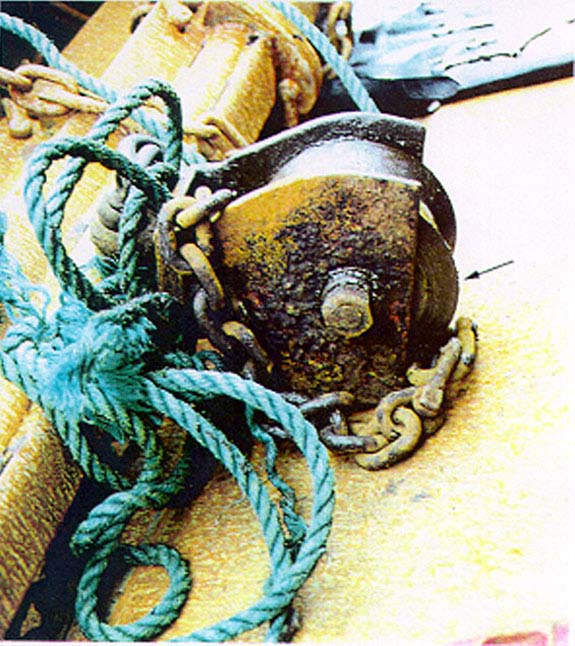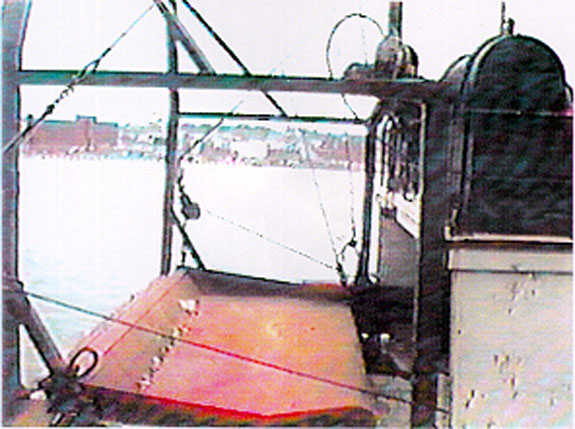Injury
The Fishing Vessel "RYANE & SISTERS"
Grand Banks of Newfoundland
The Transportation Safety Board of Canada (TSB) investigated this occurrence for the purpose of advancing transportation safety. It is not the function of the Board to assign fault or determine civil or criminal liability. This report is not created for use in the context of legal, disciplinary or other proceedings. See Ownership and use of content. Masculine pronouns and position titles may be used to signify all genders to comply with the Canadian Transportation Accident Investigation and Safety Board Act (S.C. 1989, c. 3).
Summary
During fishing operations on the Grand Banks of Newfoundland, a deckhand on the "RYANE & SISTERS" was struck and seriously injured while he was retrieving a fish box from beneath the raised dump table when the lifting cable parted. The deckhand sustained severe leg injuries and he was transported by rescue helicopter to a hospital in St. John's, Newfoundland.
Ce rapport est également disponible en français.
Factual information
| Name | "RYANE & SISTERS" |
|---|---|
| Port of registry | St. John's, Newfoundland |
| Flag | Canada |
| Official number | 803747 |
| Type | Fishing vessel |
| Gross tonnage | 72.04 |
| Length | 18.28 m |
| Built | 1987 |
| Propulsion | Diesel, 402 kW |
| Number of Crew | 6 |
| Registered owner | Anthony V. Clowe 40 Flaherty Crescent, Mount Pearl, Newfoundland |
The "RYANE & SISTERS" is an east coast Cape Island type wooden hulled vessel with the wheelhouse and accommodation forward and a partly sheltered work deck located aft over the fish hold (see Appendix A, Photo 1).
A steel "A" frame structure straddles the work deck aft from which two scallop rakes are deployed. The dump table is located across the stern between the 'A' frame side posts and is hinged at the after end. Separate trawl winches are used for hauling in each port and starboard rake. A topping winch serves to raise and lower the dump table and to manoeuvre the retrieved rakes to and from the table (see Appendix A, Photo 2).
The topping winch is located on the starboard side of the shelter deck rail at 95.25 cmFootnote 1 from the centre line.
The dump table consists of a wooden platform bolted to a steel frame and enclosed with steel plating. It extends athwartships 4.9 m over the work deck, with a hinged attachment at the stern bulwark. The forward edge of the table measures 2.3 m from its hinges to the lifting lug and rests horizontally on steel legs to provide an underside clearance of 0.53 m above the deck. The weight of the table structure in a clean state is estimated to be 1.25 t (see Appendix A, Photo. 5).
The galvanised steel wire lifting cable was 1.27 cm in diameter right regular lay 6 X 25 filler with an independent wire rope core. It was led aft from the topping winch drum, up to and through a 22.86 cm single sheave topping (lifting) block which hung from the centre line beam at the head of the "A" frame, and led down to the working deck.
When the "RYANE & SISTERS" is scallop fishing, the two rakes are deployed from the stern and dragged over the scallop grounds. The loaded rakes are retrieved at regular intervals and their contents emptied onto the dump table. The empty rakes are then re-deployed for dragging while the deck crew sort through the contents of the dump table for scallops. When all of the scallops have been collected in plastic boxes, the table is raised on its hinges and sea-floor residue is dumped back into the ocean (see Appendix A, Photo. 6). Meanwhile, the deck crew shuck, clean, and bag the scallops for stowage in the fish hold and the cycle continues.
On 18 May 1997, upon heading out from St, John's, Newfoundland, the crew was split into two watches working six-hours-on and six-hours-off. The captain and the mate alternated the bridge watch while the remainder of the crew were engaged in deck operations and shucking the catch.
On 26 May 1997, in position 45°18′ N, 49°07'W, some 200 miles off the Newfoundland coast, the vessel was in the process of hauling in the loaded rakes when the table was raised into the dumping position. An empty scallop box had moved over the deck and was lodged at the aft bulwark in way of the raised dump table. The attending deckhand went to retrieve the plastic box, a practice which reportedly had been carried out during this and other trips.
At about 2330,Footnote 2 while the deckhand was stooping under the raised dump table, the topping lift cable parted, the dump table fell, striking and seriously injuring him.
The dump table was raised again using the secondary topping lift and the injured man was removed from the dump table area.
The master contacted St. John's Coast Guard Radio Station for medical assistance and arrangements were made for a medical evacuation (medivac).
The scallop rakes were retrieved and the vessel headed for St. John's. A search and rescue (SAR) helicopter was dispatched to the vessel and transported the injured deckhand to the Health Science Centre in St. John's.
As a result of being struck by the dump table, the deckhand suffered a fractured right femur and left tibia as well as scrapes and bruises. He was 19 years old, making his first trip this year and had made only one other trip to sea. He held no marine certification nor had he taken any marine safety training, although these were not required by authorities at the time.
It happens that the crew of the vessel may change from one trip to the next. Deckhands can be hired "off the wharf" on short notice with little time to assess their seagoing experience or abilities.
The recently formed Newfoundland and Labrador Professional Fish Harvesters Certification Board intends to implement a program for the eventual certification of all professional and apprentice fish harvesters.
The "RYANE & SISTERS" had a valid ship safety inspection certificate SIC 29 extended to expire 17 May 1999.
The weather at the time of the occurrence was reported to be winds southerly 25 knots with visibility 6 to 8 km with light rain and an air temperature of 3°C. The vessel reportedly had its stabilizers deployed and was rolling very little.
The topping winch was rated to be capable of exerting a pulling force ranging from 2.6 to 3.9 t, depending upon whether the cable drum was full or bare.
The topping lift cable when new, had a safe working load (SWL) of about 2.2 t. It showed signs of wear extending approximately 1.5 m on each side of the point of failure. Indications of cable crushing and heavy smearing were evident. It was reported that the cable had been newly installed just prior to the previous trip.
The topping block was a second-hand towing/trawl block normally used to guide warp cable over the stern for dragging fishing gear. It had been installed as a topping block several trips previously. The surface of the sheave had been built up with weld and the groove was improperly shaped to support and guide the lifting cable. There were signs of concentrated wear over one side of the wide roller-type sheave groove and indications were that the cable had at times moved over the edge of the sheave to rub on the cheek of the block (see Appendix A, Photos 3 and 4).
Reportedly, fishing gear, blocks, and cables were inspected by ship's personnel after every trip.
Both lengths of the parted wire cable were recovered for analysis by TSB Engineering Laboratory.
Analysis
It is common practice amongst small fishing vessel operators to hire crew "off the wharf" for fishing trips. Those hired have a varied background and may be taken on board without the skipper being fully aware of their seagoing experience or lack thereof.
In order to learn safe working skills and practices on small fishing vessels such as the "RYANE & SISTERS", novice deckhands rely greatly upon experienced crewmen to provide "on-the-job" training. At the time of the occurrence, there were no regulatory certification or minimum training requirements for deck crew on small fishing vessels.
The injured deckhand was on his second trip to sea on a scallop dragger and was learning the job as he performed it. He may not have been fully aware of the shipboard practice not to stand, work, or pass under a suspended load. The scallop box could have been retrieved from under the dump table after it was safely shored-up or placed in the "down" position.
The topping winch power was such that shock loading could have occurred during times when the table contents were being dumped. The raised table may have been tugged against its anchored hinges by a winch pull in excess of the SWL of the cable. This would cause extreme tensile stress and cable damage.
The block was not the proper type for use with a 1.27 cm lifting cable under heavy load. The undersized block diameter imposed an excessive bending moment on the cable causing severe deformation, cable crushing, and accelerated wear which greatly reduced its lifespan.
Microscopic examination of the broken ends of several strands showed necking and rupture consistent with overstress failure.
TSB Engineering Laboratory report LP 90/97 on Cable Failure is available upon request from the TSB.
Findings
- The lifting cable failed as a result of accelerated wear and overstress tensile rupture.
- The block had an improperly shaped and undersized sheave groove diameter, imposing an excessive bending moment on the lifting cable, severely reducing its lifespan.
- The topping winch was capable of exerting tensile shock loads in excess of the SWL of the cable when the dump table was being emptied.
- The deckhand took an unnecessary risk in passing under the suspended dump table.
- The deckhand suffered a fractured right femur and left tibia as well as scrapes and bruises as a result of being struck by the falling dump table.
- The injured deckhand was on his second trip to sea on a scallop dragger and was learning the job as he performed it.
- Provincial certification and minimum training requirements for deck crew on small fishing vessels were not yet in effect.
Causes and Contributing Factors
The deckhand was seriously injured when he was struck by the falling table after the lifting cable parted. Contrary to safe working practices, the deckhand placed himself in a dangerously unsafe position under the suspended dump table. Post occurrence analysis of the parted cable indicated that it failed as a result of overstress tensile rupture.
Contributing to the failure of the cable was the use of an improper type of single sheave block whose rough condition, undersized diameter, and inappropriate sheave geometry caused accelerated wear and premature cable damage.
This report concludes the Transportation Safety Board's investigation into this occurrence. Consequently, the Board, consisting of Chairperson Benoît Bouchard, and members Maurice Harquail, Charles Simpson and W.A. Tadros, authorized the release of this report on .





